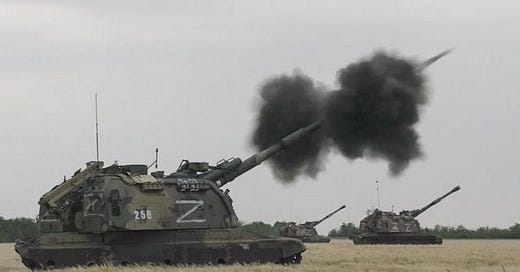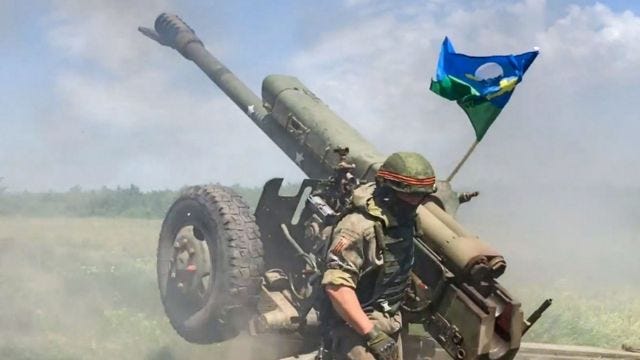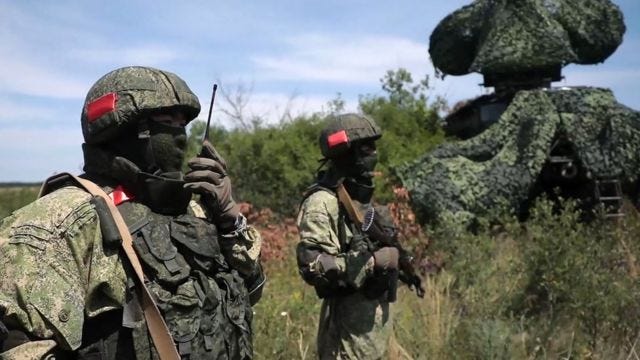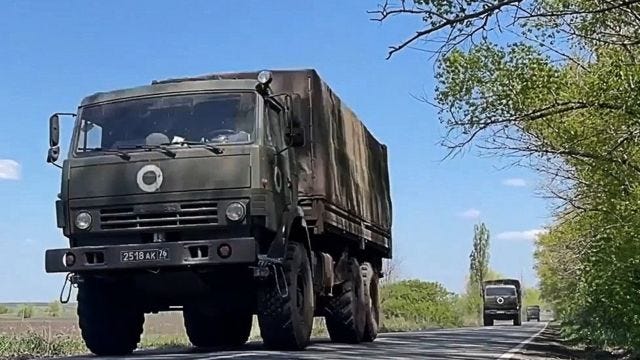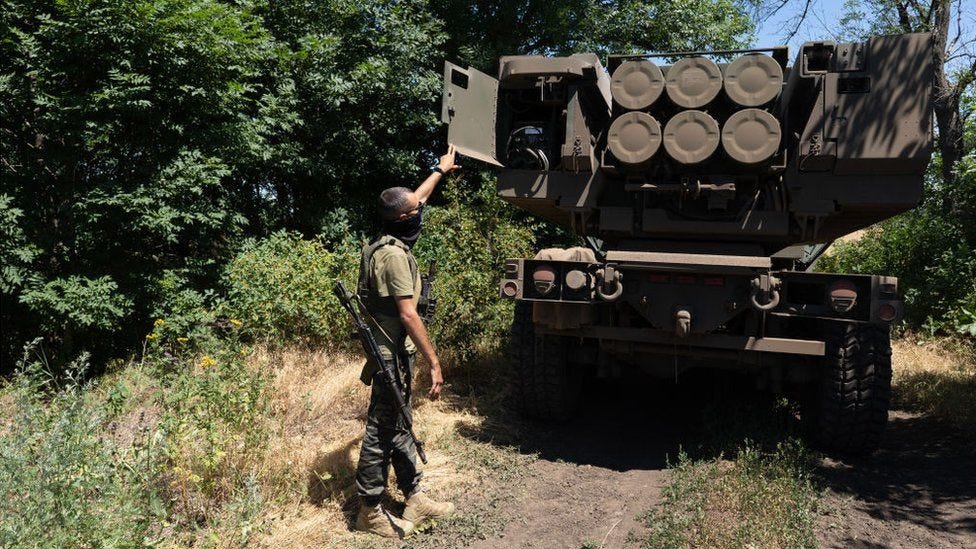Is Russia really ready for a new offensive in Ukraine?
After an apparent pause in operations in early July, statements by both the Defence Ministry and President Vladimir Putin indicate forces are regrouping for a renewed assault.
By Pavel Aksenov, Grigor Atanesian and Ilya Abishev
Is Russia planning a major new offensive in Ukraine? After an apparent pause in operations in early July, statements by both the Defence Ministry and President Vladimir Putin indicate forces are regrouping for a renewed assault. When could this new chapter in the conflict begin, and does Russia actually have the military resources to do it?
In the days and weeks leading up to the invasion of Ukraine, the Kremlin insisted that the massive military build-up on the Ukrainian border was just a preparation for large-scale war games.
Five months later, Vladimir Putin is now talking openly about plans to unleash a ‘full frontal assault’ on Ukraine. But this time, as observers point out there is no sign of the huge numbers of troops on the frontline that such a renewed offensive would require.
What would a “new campaign” look like?
On February 24, Russia launched an invasion of Ukraine. Prior to doing so, it had amassed 150 to 200 thousand fighters on Ukraine’s borders, according to various estimates. These forces were made up of Russian troops alongside armed militias from the Russian-controlled "people's republics" of Donetsk and Luhansk regions.
It’s clear that Russia initially intended to fight a very different campaign to the offensive that became the reality between May and June.
In the first weeks of the invasion, Russian troops tried to break through to Kyiv from the north and northeast of the Ukrainian capital. Commanders hoped that rapid, powerful military strikes would allow troops to make breakthroughs in the Donbas. These attacks would supposedly also be supported by operations in the south of Ukraine which could be launched easily from Crimea. While this strategy remains unofficial and was not commented on by the Kremlin, Russian troop movements and tactics indicate Moscow expected this “blitzkrieg” would be overwhelmingly successful.
This type of “rapid-strike” warfare requires a pre-planned build-up of forces which can be unleashed en-masse on the enemy’s defences, potentially bringing about victory quickly and totally. The target of these “strikes” may be key military, industrial or political centres (for example, the capital).
In American military doctrine, this brand of warfare is often referred to as “shock and awe” tactics. It involves not only conventional combat operations, but also a large-scale information campaign targeted at the civilian population. This was observable in the Russian invasion of Ukraine, a notable example being Putin’s call for the Ukrainian military to "take power into their own hands.”
However, the Russian army found itself unable to inflict this type of crushing defeat at the beginning of the conflict. When troops got bogged down in the fighting near Kyiv, Russia withdrew its forces from the Ukrainian capital as well as the Chernihiv and Sumy regions. Commanders were told to concentrate largely on the fighting in the Donbas.
On April 22, the Deputy Commander of the Russian Central Military District, Rustam Minnekaev, announced that the second phase of the conflict was beginning. Russia’s goal now would be "to establish complete control over the Donbas and southern Ukraine."
In the opinion of many experts, this “second phase” marked a fundamental change in Russia’s strategy. Russian commanders’ view of the conflict as a brief war which would be won via a quick and crushing victory was gone. Instead, they began to view the conflict as “war of attrition” which could not be won by seizing a single target.
The Russian army’s main task became simply stripping Ukraine of its resources. This was largely achieved by weakening the country’s economy and military. The type of “war of attrition” which the conflict has become does not preclude the setting of purely military goals and objectives - they have simply become less ambitious.
If Russian commanders wish to attempt the “crushing blow” they need to end the war of attrition which the conflict has become, they will need to achieve an overwhelming military advantage over Ukrainian forces at a strategic point in the frontline. This would require a grouping of troops with the numbers, training and equipment to effectively overcome any Ukrainian resistance.
This is no easy feat. After several months of ongoing conflict, Ukraine’s military infrastructure has been tried and tested and is gaining momentum.
Thanks to reconnaissance, primarily obtained via satellite, Kyiv will also have prior warning of where and in what numbers Russian forces have assembled for a new strike. Ukraine’s newly long-range and high-precision weapons have made it possible for their own troops to target these areas.
Alternatively, Russian commanders may continue to pursue an attrition-oriented conflict. This option does not mean a stalemate has been achieved. Efforts to push forward will likely continue. The goals of such attacks vary, ranging from the encirclement of an enemy grouping to taking new territory or capturing an industrial or economic centre.
The key difference between these two strategies lies in the fact that for a “rapid strike” the Russian army needs to accumulate as many troops as possible before the start of the strike, whereas in a “war of attrition” it would need ensure it maintains a constant and uninterrupted supply of weapons, military equipment and personnel to make up for its inevitable losses.
From an economic point of view, in the “rapid strike” scenario, one would expect large Russian defence orders and strict state control over their execution. A successful war of attrition would most likely require the Kremlin to intervene in order to stabilise and support Russia’s economy and military-industrial complex.
Where is the attack expected?
The use of “one powerful strike” has been widely advocated by various pro-Russian commentators on social networks and message boards.
These posters and bloggers criticise the actions of the Kremlin, which continues to call the conflict a “special military operation”. They accuse Russia’s leaders of indecision and promote the idea of officially starting a full-scale war with Ukraine, declaring martial law and general mobilisation. According to them, a military victory in the conflict with Ukraine is impossible without these stringent measures being employed.
Military experts told BBC Russian that they do not consider it likely that Russia will be able to land the type of “devastating blow” on a large military target it had hoped to at the start of the war.
"It is very unlikely that Russia can take Kyiv or any other of the big cities - Kharkiv, Zaporizhie or Odesa," says Rob Lee of the Foreign Policy Institute in Washington.
Less ambitious military operations will, however, obviously continue to take place. According to the Israeli military expert David Gendelman, there are several potential theatres of war which could become active at once.
“Kharkiv and Kherson are areas of particular importance,” he told the BBC.
“In the Kharkiv area, we see a strengthening of Russian forces. It is not enough to storm or capture the city itself, but is more than enough to pin down a large grouping of the Armed Forces of Ukraine, and take some territory around the city. In the Kherson region, we have seen an increased Russian military presence, including through the transfer of forces from Zaporizhia."
The most logical target would be somewhere in the south, a Russia-based expert told the BBC, speaking on condition of anonymity. He said the political goal was obvious - - to cut off Ukraine from the sea.
" Ukraine has announced that it is planning to carry out a counteroffensive in the south of the country,” he continued. “I have questions about that: would they declare their intentions so openly if they really wanted to launch this type of attack? In any case, the south looks more promising because not only military but also political goals can be achieved there.”
David Gendelman says the position of the Russian troops near Kherson is complicated:
“This is a weak point of the Russian defence for geographical reasons. There are only limited supply capabilities across the two bridges which span the Dnieper River. The Ukrainian army maintains a consistent presence close by and carries out minor counter-offensive actions and harasses Russian troops. This means the Russian army must strengthen its position in this area if it wants to avoid losing Kherson and preserve the potential advantages the area gives for mounting offensive operations.”
“Almost the entire southern front of the Russian army has relatively low operational capabilities and relatively low numbers of troops,” Gendelman continues.
“This is largely because the bulk of the Russian army is concentrated in the Donbas. It means the Armed Forces of Ukraine have more opportunities to attack, and, accordingly, the Russians should take this into account and strengthen these sectors if possible.”
Until recently, the most intense battles of the war have been fought in the Donbas. Russia has said the goal is to capture the entire Donetsk region, so this focus is likely to continue, Gendelman says.
Rob Lee agrees that a large-scale Russian offensive outside the Donbas is extremely unlikely. He points out that such an attack would require a large number of well-equipped units unavailable to the Russians, whose troops are now largely being reinforced by those who have entered into a short-term contract.
“Manpower is the issue,” he told the BBC. “The Russians don’t have that many units capable of doing offensive operations effectively. . Their best troops are in the Donbas, which means they can't do too much elsewhere. ”
Where will reinforcements come from?
“Manpower” such as troops, mechanics and support personnel that the American analyst discussed are really a big problem for Russia, as well as for Ukraine.
In its analytical brief dated July 12, the British Ministry of Defence wrote that personnel shortage of the Russian armed forces may force the Russian Ministry of Defence to resort to “non-traditional recruitment” .
"This includes recruiting personnel from Russian prisons for the Wagner Private Military Company. If true, this move likely indicates difficulties in replacing the significant numbers of Russian casualties," the British intelligence update stated.
Whatever the final decision, Russia will need manpower. Supporters of a "crushing victory over Kyiv" say that such a victory is impossible without general mobilisation. “A war of attrition” requires fewer resources, and, as Rob Lee notes, Russia has so far lacked the personnel necessary to pursue other options.
“Back in May, there were big questions about whether [Vladimir Putin] had to do a general mobilization in order to continue the campaign,” Lee says. “But he didn't do that and they had success. But it's an open question: will they have enough guys months from now?”
According to David Gendelman, the Russian army lacks the personnel to achieve wider military goals in a long conflict.
“Ideally, from a purely military standpoint, mass mobilisation would be enacted for the foreseeable future, largely because Russia’s current resources are, at most, only sufficient to allow for a slow advance in a few areas. Yet, as has been said more than once, mass mobilisation in Russia is a controversial political issue which the authorities will desperately try to avoid by utilising all other resources available. This may mean the recruitment of volunteers, mobilisation of the populations in the LPR and DPR, or even putting together new battle tactical groups from the regular army," he says.
The political problem of general mobilisation, which Gendelman speaks of, is compounded by organisational issues. An anonymous Russian expert spoke of this problem.
“We don’t currently have a mechanism that allows us to quickly call up a large number of conscripts from the reserve and then quickly train and arm them. There is the possibility of limited mobilisation, but, as far as we can tell, this is already happening. In principle, it seems many former soldiers, including those who have recently retired, are being offered short-term contracts. They have called up administrative staff from the military registration and enlistment offices. All that happens is letters are written and someone automatically agrees. This applies to almost all branches of the armed forces, from ground forces to pilots,” he said.
Will Russia have enough ammunition?
The Russian army consumes a huge amount of ammunition. According to the Ukrainian edition of Forbes magazine, at the height of the battles for Donbas about two thousand tons of shells were being used every day.
In his telegram channel, military expert Viktor Murakhovsky pointed out that one rifle battalion can use up its entire supply of munitions - more than 80 tons of ammunition - in a single day.
It is practically impossible to reduce the Russian consumption of shells with existing army tactics. According to David Gendelman, “in general, the advance of the Russian army is largely due to its advantage in firepower. This is dependent on a continuous supply and consumption of a large amount of ammunition.”
These ammunition stocks, according to him, will be enough for Russia for the foreseeable future, but there is a problem with delivering these resources to the troops on the ground: “Since teleportation has not yet been invented, ammunition is delivered by road and rail and then stored in warehouses behind the lines.”
According to a report by the Royal United Services Institute (RUSI) in London, the main weakness of Russian artillery is logistics. RUSI analysts argue that Russia has more than enough ammunition to go around. The report states that “in addition to vast stockpiles that the Soviet Union accumulated, and which have yet to be depleted – by some estimates, several years’ worth still remains – the Russian defence industry has a significant capacity for producing artillery shells.’
But the problem is getting that ammunition to the right places.
"The ammunition dumps at the divisional and brigade level are large, distinct, hard to conceal or defend, and slow to relocate," British experts say.
Warehouse problems
With such a large expenditure of shells, before the start of a new major campaign the Russian army will be forced to solve an acute problem it has encountered in recent weeks.
Since the Ukrainians received and were trained to use Western long-range artillery, they have been able to inflict targeted strikes on military bases, command centres and fuel and ammunition depots deep behind Russian lines.
According to BBC News Ukraine, at least 15 large Russian army storage facilities have been destroyed as a result of shelling over the past two weeks.
Russia may have several options for solving this problem:
Strengthen air and missile defences, as well as electronic countermeasures.
Establish counter-battery combat alongside using aviation and sabotage and reconnaissance groups to destroy enemy long-range weapons.
Destroy or cut off the supply routes of ammunition for Ukrainian systems.
Use underground warehouses and camouflage.
Move large military facilities, primarily ammunition depots, to even further behind their lines, so they are situated in location Ukrainian artillery cannot reach.
But for the time being, none of these methods is guaranteed to solve the problem.
Russia already makes a great deal of use of air defence systems and electronic warfare in Ukraine. The effectiveness of these means, however, raises questions - it has been shown American rockets can overcome Russian air defences.
Those high-precision long-range projectiles are also at the disposal of the armed forces of Ukraine alongside conventional artillery rockets.
On July 8, it became known that the next package of American military assistance to Ukraine would include 155mm high precision-guided munitions. The exact specifications of these weapons is unknown, but press speculation indicates that this shipment could include M982 Excalibur shells which have high levels of accuracy and can hit targets 40 to 57 kilometres away.
The M982 Excalibur can be fired from the German PzH 2000 self-propelled artillery mounts or the American M109A3GN, both of which are already being used in Ukraine.
It is possible that Ukrainian troops will not be able to fire these new shells from the M777 howitzers they generally use. Footage of these American howitzers, distributed by Ukrainian official and unofficial sources, features guns without the special blocks needed to use high-precision ammunition. This is however, unconfirmed.
Even ordinary 155-millimetre shells can still hit targets 40 km away and some artillery systems can hit even further away.
Shooting down an artillery shell with conventional air defence systems is almost impossible, especially when the shelling is carried out by a whole battery. In order to organise an artillery defence against these gun systems, it is necessary to have guns at least as good in terms of range and accuracy.
This is not enough - Russia needs reconnaissance systems, means of target designation and the flexibility to make fire adjustments. Neither the M142 HIMARS or M270 MLRS, using tactical missiles, nor any howitzer or self-propelled gun that is fired from the Excalibur, can stay in one place for long - they shoot and immediately move on.
Aviation can effectively suppress any enemy artillery but with an active enemy air-defence systems it would be at a cost - destroying an artillery piece but losing a plane is a bad trade. Not to mention the fact that a plane can be destroyed from kilometres away.
It is possible to use sabotage and reconnaissance groups to hunt for stray missile launchers, but you have to get lucky. "Hammers" and other types of powerful equipment do not travel without combat guards, and the Ukrainian counter-sabotage units have proven difficult to get past.
Cutting off arms supply lines is a logical idea - if it can be implemented. The territory of Ukraine is huge and there are a great many roads. This is the logic behind proposals in pro-Kremlin and nationalist circles to bomb bridges across the Dnipro to cut off supply lines and starve the Ukrainian army out of the Donbas.
Bridges, however, are not the easiest targets. Even a large bridge is still not particularly wide. These structures also rest on solid foundations which can withstand a lot of fire. To make things even more difficult, such important strategic targets are usually well-defended by air defence systems.
Any operation to destroy the bridges would be labour-intensive, costly and lack any guarantee of success - especially if conducted from afar via Iskander and Calibre rockets. The use of bombers is also extremely risky as it is very likely that the planes will be shot down.
Disguising defence systems would be the ideal solution. However, in the case of the large, stationary military facilities used by the Russian army, disguise is almost impossible. The location of these facilities is not a secret to the Ukrainian command, and artillery has already hit several known coordinates.
Underground warehouses could be an acceptable solution to the problem. Such underground storage facilities would, however, need to be located near supply lines and must meet safety requirements - not to mention to be huge in scope. It also remains difficult to hide their location - sooner or later the enemy will either notice the construction site or track traffic flows to ascertain where they are.
You cannot, of course, put all your eggs in one basket. If resources were distributed among many smaller warehouses, it would be harder to target them. It would also, however, be necessary to significantly increase security and maintenance costs, while the risk of an isolated strike remains. One should not discount the fact that the enemy may also decide to attack even a small target which it ascertains has strategic value.
Finally, commanders could simply move the warehouses of equipment, ammunition, fuel and other material supplies deep into Russia-controlled territory to distances up to 90-100 km from the front line. This obvious solution, however, creates its own logistical problems.
According to David Gendelman, it is very difficult to solve these types of issues during wartime. “It is impossible to dramatically increase the number of vehicles under the existing conditions, but the dispersal and protection of warehouses is a laborious and long process in wartime, it is always better to do this in advance. Therefore at least for the near future, the vulnerability of ammunition depots and fuel and lubricants will remain a weak point for Russia. Improvement, even with the necessary effort, will take time.”
The supply chain usually begins in warehouses located in the depths of Russia, where ammunition is loaded onto wagons and delivered by rail to rear warehouses located either in Ukraine or in adjacent territories. From there, they are transported by road to front-line warehouses.
If the secondary warehouse is 30-40 km away from the front line, one truck can perform two or three trips per day. At 90-100km away from the lines, only one trip is possible. As such, it would be necessary to triple the number of both machines and maintenance personnel.
According to a Russian expert, who preferred to remain anonymous, the only way the Russian army is able to cope with the problem of distribution is by throwing resources at the issue.
“We need to use more trucks, more military drivers. This, by the way, is one of the jobs in which we just have no personnel. If you remember, the conscripts who were captured at the beginning of the war were also drivers. Then there were not enough contract soldiers. After all, contractors prefer to be sent to less strenuous positions."
“This problem will, however, have to be solved somehow. It can be solved, because the supply of cars is not even close to being exhausted. There are ways to get drivers, but this is a measure that is only being taken now,” he said.
However, the question of organisation remains.
The number of vehicles and their time on the road will increase. This means more convoys which are vulnerable both to attacks from the air and to artillery and saboteurs. This means more resources will need to be committed to supply-line defence.
The dispersal of warehouses would also require a more complex system of accounting and distribution to keep track of various types of cargo, information and communication. Finally, more logistics specialists would need to be recruited.
Changes in Command Staff
The failure to achieve the initial strategic goal of capturing Kyiv and defeating the Ukrainian army, appears to have lead to a reshuffle at the top of the Russian army.
On 25 June, the UK Ministry of Defence, posted an update on Twitter citing new intelligence claiming several Russian generals had been dismissed from command positions. They included the commander of the Airborne Forces, Colonel-General Andrei Serdyukov and the commander of the Southern Military District, Army General Alexander Dvornikov.
Russia has not confirmed this information, and on the Russian Defence Ministry website both men are still listed as being in their roles.
There is also speculation that Deputy Prime Minister Yuri Borisov, who oversaw the military-industrial complex, may be about to resign. He has been organising the production of weapons and military equipment in Russia since 2018, but has been directly associated with the “defence” industry since the late 1990s.
According to a Russian expert in conflict studies, the Russian government is already trying to change the command structure, attempting to find more competent commanders.
“Our army is suffering from poor selection. The higher you travel up the totem pole, especially in the category of generals, the greater the chance that we will encounter an incompetent individual, who has outgrown his competency, and has risen based on his loyalties. However, there is still always a certain number of those who work hard, and on whom everything rests. We need to choose from among them,” he says.
According to the expert, rumours about the reshuffling of troop commands have been moving through military circles. However, the extent and particulars of these replacements are unknown.
Israeli expert in conflict studies, David Gendelman believes that such a change of command staff is unlikely to lead to positive results.
“For now we have seen a changeover of battle tactical groups. This also sometimes happens at a lower level, including as a result of casualties. At the highest level, however, this type of personnel shuffling rarely offers any benefit. The personnel on average are what they are, and we need to work with what we have. As Comrade Stalin said, "We have no Hindenburgs in reserve," he notes.
"In general, the problems facing the Russian Army in this war are not due to specific unsuitable unit commanders, but because of the broad design, conduct, and preparedness of the forces towards combat. It cannot be fixed by replacing these people at the lower level.” the Israeli military expert emphasises.
According to Rob Lee, while the mistakes made by the Russian command are quite obvious to specialists, the decision to change the commanders of units and formations often occurs because politicians take out their frustrations on their subordinates, when in fact, the fault lies with themselves.
Read this story in Russian here.

